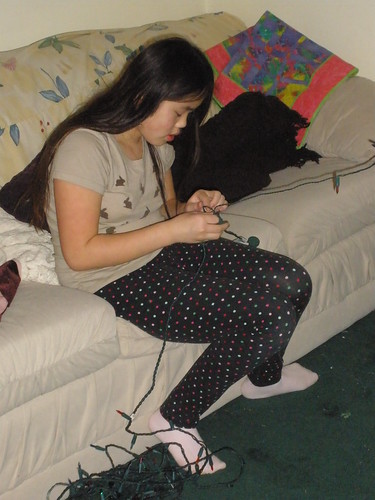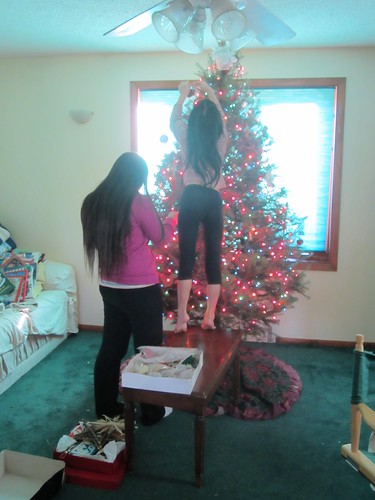Activities
Sophia had a one-hour harp rehearsal at church at 10:00 a.m.
Sophia with her harp teacher, Denise, practicing a duet.
She has five songs that she is playing tomorrow at church during two services.
The organist timed each of the pieces so they would know
when to begin the prelude.
Sophia's skill has improved greatly over the past two years, and she is very comfortable now performing in front of groups.
The ensemble playing a French song.
There are two harps, a violin, and organ used in this piece.
She practiced the songs that were duets with her harp teacher, Denise; and also practiced the songs that will be part of ensembles (with organ, violin, and another harp).
In the afternoon, the girls visited their step-grandpa. Sophia and Dan made brownies together so everyone could enjoy them together after they were baked.
The girls brought home some wrapping paper and bows that Dan gave them, and wrapped a couple more presents in the evening.
I also was able to get about half of the presents wrapped which was a huge relief!
For dinner, we had another Mexican-inspired meal: tacoritos.
Tacoritos that I made.
This was a new recipe I saw in Taste of Home that I wanted to try. It was well-received by most everyone (although Olivia ate some of it, she probably wouldn't eat it again).
1/4 cup butter, cubed
1/4 cup all-purpose flour
4 cups water
3 tablespoons chili powder
1 teaspoon garlic salt
1 pound ground beef
1 pound bulk pork sausage
1/4 cup chopped onion
1 cup refried beans
8 flour tortillas (8 inches), warmed
3 cups (12 ounces) shredded Monterey Jack cheese
Optional toppings: shredded lettuce, chopped tomatoes, sliced ripe olives and sour cream
In a large saucepan, melt butter. Stir in flour until smooth; gradually add water. Bring to a boil; cook and stir for 1 minute or until thickened. Stir in chili powder and garlic salt. Bring to a boil. Reduce heat; simmer, uncovered, for 10 minutes.
In a large skillet over medium heat, cook the beef, sausage and onion until meat is no longer pink; drain. Stir in refried beans; heat through.
Spread 1/4 cup sauce in a greased 13-in. x 9-in. baking dish. Spread 1 tablespoon sauce over each tortilla; place 2/3 cup meat mixture down the center of each. Top each with 1/4 cup cheese. Roll up and place seam side down in prepared dish. Pour remaining sauce over the top; sprinkle with remaining cheese.
Bake, uncovered, at 350° for 18-22 minutes or until bubbly and cheese is melted. Serve with optional toppings if desired. Yield: 8 servings.
*~*~*~*~*~*~*
Advent Reading
Luke 2:17-20 - When the shepherds saw him, they told them what the angel had said about the child. All who heard it were amazed at what the shepherds said. Mary remembered all these things and thought deeply about them. The shepherds went back, singing praises to God for all they had heard and seen; it had been just as the angel had told them.
*~*~*~*~*~*~*
Christmas Joke
Why are elves so depressed? (Because they have low elf esteem.)
*~*~*~*~*~*~*
Christmas Fact
We learned why we put Christmas lights on the tree:
People started putting lights – candles to be more specific – on Christmas trees in the middle of the 17th century. These were attached to the end of tree branches with wax or pins and were adhered to the tree to represent shining stars. This tradition started in Germany and spread to Eastern Europe over the next two centuries.
Because this was a serious fire hazard, most people did not put their trees up until December 24, ensuring that they would only be up for a brief period of time while the tree was still fresh – and much less flammable.
The custom of putting strings of lights on trees began in 1882 when Edward Johnson – an associate of Thomas Edison – wired red, white and blue bulbs together and placed them on an evergreen tree. In 1895, President Grover Cleveland followed suit and decorated a Christmas tree in the White House with stringed lights. The public took notice, and the tradition started to catch on.
The girls were hanging lights on the tree in 2009.
However, it was extremely expensive to have a lit Christmas tree. General Electric sold bulbs for this purpose, but they needed to be wired together by a professional electrician. Additionally, if a homeowner wanted a lit Christmas tree, but did not have electricity yet, they’d have to purchase a generator to keep the lights on.
In 1903, the American Eveready Company developed an easier to use light set involving screw-in bulbs and a plug-in for the wall socket. Even with this easier to use equipment, electric tree lights were not catching on rapidly. People were still using unsafe candles as a way to light their trees, until Albert Sadacca came up with the idea to make the lights multi-colored in 1917.
Sophia was in charge of the lights in 2010.
He and his two brothers Henri and Leon started NOMA Electric Company, which became the largest Christmas lighting company in the world. Since that time, lights have continued to evolve.
Olivia working with the lights in 2011.
Miniature bulb sets came about in the late 1960s and came in strands of 25 or 50 lights. These were very similar to the standard miniature lights available today. However, there are more options available for size and color today than there were in the past.
Decorating the tree with lights and ornaments in 2012.
The latest advancement in holiday lights is the use of LED (light-emitting diode) technology.
Sophia putting lights on the tree in 2013.
These lights are far more efficient than incandescent lights and have a much longer life-span.










No comments:
Post a Comment